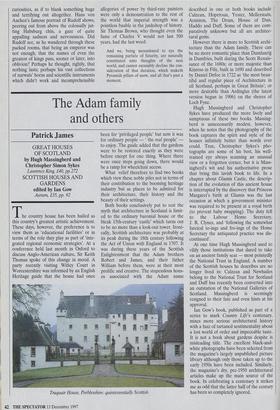The Adam family and others
Patrick James
The country house has been hailed as this country's greatest artistic achievement. These days, however, the preference is to view them as 'educational facilities' or in terms of the role they play as part of 'inte- grated regional economic strategies'. At a conference held last month in Oxford to discuss Anglo-American culture, Sir Keith Thomas spoke of this change in mood. A party recently visiting Witley Court in Worcestershire was informed by an English Heritage guide that the house had once been for 'privileged people' but now it was for ordinary people — the real people' — to enjoy. The guide added that the gardens were to be restored exactly as they were before except for one thing. Where there were once steps going down, there would be a ramp for wheelchair access.
What relief therefore to find two books which view these noble piles not in terms of their contribution to the booming heritage industry but as places to be admired for their architecture, their history and the beauty of their settings.
Both books conclusively put to rest the myth that architecture in Scotland is limit- ed to the ordinary baronial house or the bleak 15th-century 'castle' which turns out to be no more than a look-out tower. Ironi- cally, Scottish architecture was probably at its peak during the 18th century following the Act of Union with England in 1707. It was during these years of the Scottish Enlightenment that the Adam brothers Robert and James, and their father William before them, were at their most prolific and creative. The stupendous hous- es associated with the Adam name Traquair House, Peeblesshire: quintessentially Scottish described in one or both books include Culzean, Hopetoun, Yester, Mellerstain, Arniston, The Drum, House of Dun, Haddo and Duff. Some of them are com- paratively unknown but all are architec- tural gems.
However there is more to Scottish archi- tecture than the Adam family. There can be no more romantic place than Dumlanrig in Dumfries, built during the Scots Renais- sance of the 1680s; or more majestic than Kinross in Fife, built in 1690 and described by Daniel Defoe in 1722 as 'the most beau- tiful and regular piece of Architecture in all Scotland, perhaps in Great Britain'; or more desirable than Ardinglas (the latest version begun in 1906) on the shores of Loch Fyne.
Hugh Massingberd and Christopher Sykes have produced the more lively and sumptuous of these two books. Massing- berd is unnecessarily modest, however, when he notes that the photography of the book captures the spirit and style of the houses infinitely better than words ever could. True, Christopher Sykes's pho- tographs are some of his best, his well- trained eye always scanning an unusual view or a forgotten corner, but it is Mass- ingberd's wit and his authoritative prose that bring this lavish book to life. In a chapter about Glamis Castle, the descrip- tion of the evolution of this ancient house is interrupted by the discovery that Princess Margaret's birth at Glamis was the last occasion at which a government minister was required to be present at a royal birth (to prevent baby swapping). The duty fell to the Labour Home Secretary, J. R. Clynes, and 'following the somewhat farcical to-ings and fro-ings of the Home Secretary the antiquated practice was dis- continued'.
At one time Hugh Massingberd used to vilify those institutions that dared to take on an ancient family seat — most pointedly the National Trust in England. A number of the Scottish houses he describes are no longer lived in: Culzean and Newhailes belong to the National Trust for Scotland and Duff has recently been converted into an outstation of the National Galleries of Scotland. Massingberd is seemingly resigned to their fate and even hints at his approval.
Ian Gow's book, published as part of a series to mark Country Life's centenary, mixes more serious architectural history with a fuzz of tartaned sentimentality about a lost world of order and impeccable taste. It is not a book about gardens despite is misleading title. The excellent black-and- white photographs have been selected from the magazine's largely unpublished picture library although only those taken up to the early 1950s have been included. Similarly, the magazine's dry, pre-1950 architectural articles make up the main source of the book. In celebrating a centenary it strikes me as odd that the latter half of the century has been so completely ignored.


















































































 Previous page
Previous page